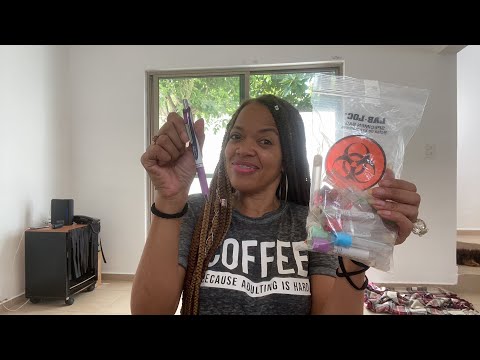Medical Assistant vs. Phlebotomist: Which is Right for You?
Contents [show]
Considering a career in the medical field? Not sure if you should become a medical assistant or phlebotomist? Check out this blog post to learn more about the differences between these two roles to help you decide which one is right for you.
Checkout this video:
What is a medical assistant?
Medical assistants are specially trained to work in physicians’ offices, clinics and other healthcare facilities. They perform both administrative and clinical tasks. The duties of a medical assistant vary from office to office, but usually include taking and recording vital signs, patient histories, lab results and medications. Medical Assistants also may schedule appointments, bill patients, handle correspondence and perform basic bookkeeping tasks. Some medical assistants take X-rays or give injections under the supervision of a licensed physician.
What is a phlebotomist?
A phlebotomist is a medical professional who is trained to draw blood from patients for diagnostic purposes. Phlebotomists are an important part of the healthcare team, as they help to provide information that can be used to diagnose and treat a variety of medical conditions.
Phlebotomists typically work in hospitals, clinics, or other healthcare facilities. They may also be employed by blood banks or research laboratories. In some cases, phlebotomists may travel to patients’ homes to draw blood.
Drawing blood can be a challenging task, as it requires a certain amount of skill and precision. In addition, phlebotomists must be able to effectively communicate with patients in order to put them at ease and ensure that the procedure goes smoothly.
If you are interested in a career as a phlebotomist, you will need to complete an accredited phlebotomy training program. Upon completion of your training, you will be eligible to take the national certification exam. Once you have passed the exam, you will be able to apply for state licensure, if required in your state.
What are the duties of a medical assistant?
A medical assistant is a vital member of the healthcare team who performs a variety of tasks in order to keep the office or clinic running smoothly. As the name suggests, their primary duty is to assist physicians and other medical staff with patient care. This can include anything from taking patients’ medical histories and vital signs to scheduling appointments and handling insurance paperwork. Many medical assistants also have basic knowledge of laboratory procedures and are able to perform basic testing, such as urine tests and blood draws. In some states, they may even be allowed to give injections or assist with minor surgical procedures.
What are the duties of a phlebotomist?
A phlebotomist is a professional who is specially trained to draw blood from patients. They work in a variety of settings, including hospitals, clinics, and blood donation centers.
Phlebotomists are responsible for ensuring that the blood samples they collect are of high quality and free from contaminants. They must follow strict guidelines when drawing blood, and they must be careful to avoid causing pain or injury to their patients.
In addition to drawing blood, phlebotomists may also be responsible for handling and transporting blood samples, as well as labeling and storing them properly. They may also be required to perform some basic medical tasks, such as taking vital signs or preparing patients for medical procedures.
What are the education requirements for a medical assistant?
The education requirements for a medical assistant vary by state. Some states require that medical assistants have at least a certificate from an accredited vocational school or community college, while others have no formal education requirements. Most medical assistants have completed a postsecondary education program, according to the U.S. Bureau of Labor Statistics (BLS).
A phlebotomist is a healthcare professional who draws blood from patients for laboratory testing. Phlebotomists typically have completed a postsecondary education program in phlebotomy or a related field, such as medical assisting.
What are the education requirements for a phlebotomist?
In order to become a phlebotomist, you will need to earn either a certificate or an associate’s degree from an accredited institution. Many community colleges offer programs that can be completed in as little as one semester, although most programs take between two and four semesters to complete. There are also a few online programs available, although most states require phlebotomists to complete an internship or externship in addition to the classroom hours.
What is the job outlook for a medical assistant?
Medical assistants are one of the fastest-growing occupations in the United States with an expected growth rate of 29% between 2016 and 2026, according to the Bureau of Labor Statistics. That’s much faster than the average for all occupations.
What is the job outlook for a phlebotomist?
Phlebotomists are in high demand and the job outlook is excellent. The Bureau of Labor Statistics reports that employment of phlebotomists is expected to grow 25 percent from 2016 to 2026, much faster than the average for all occupations. This demand is being driven by an aging population and the increasing need for blood tests.
Which is right for you?
There are many different types of healthcare careers, each with its own set of responsibilities and duties. So, how do you know which one is right for you? If you’re interested in a career in either medical assisting or phlebotomy, here’s a quick comparison of the two to help you make a decision.
Medical assistants are generally responsible for both administrative and clinical tasks in a medical office or clinic. They might schedule appointments, take patient histories, bill insurance companies, or perform basic lab tests. Many medical assistants also have training in phlebotomy, so they can draw blood for lab tests.
Phlebotomists, on the other hand, are specifically trained to draw blood. They might work in a hospital setting or in a mobile blood-donation unit. In addition to drawing blood, they might also be responsible for processing and storing it properly.
Both medical assistants and phlebotomists play an important role in the healthcare industry. If you’re interested in a career in either field, the best way to decide which one is right for you is to learn more about the specific responsibilities and duties of each position.
Conclusion
If you’re considering a career in the medical field, you may be wondering if you should become a medical assistant or phlebotomist. Both of these professions are important in the healthcare industry, but they have different duties and responsibilities.
Medical assistants generally have more duties than phlebotomists. They may perform administrative tasks such as scheduling appointments and answering phones, as well as clinical tasks such as taking patient vitals and giving injections. Phlebotomists, on the other hand, primarily focus on drawing blood from patients.
Becoming a medical assistant generally requires completing an accredited medical assisting program, which takes about one to two years. Phlebotomy training is typically shorter, and many programs can be completed in just a few months.
The job outlook for both medical assistants and phlebotomists is positive. The Bureau of Labor Statistics projects that employment for medical assistants will grow 23 percent from 2016 to 2026, which is much faster than the average for all occupations. The job outlook for phlebotomists is also positive, with an expected growth of 25 percent from 2016 to 2026.
So, which profession is right for you? If you’re interested in a career with a wide range of duties and responsibilities, then becoming a medical assistant may be the best choice for you. If you’re interested in a career that focuses primarily on drawing blood from patients, then becoming a phlebotomist may be the best choice for you.







